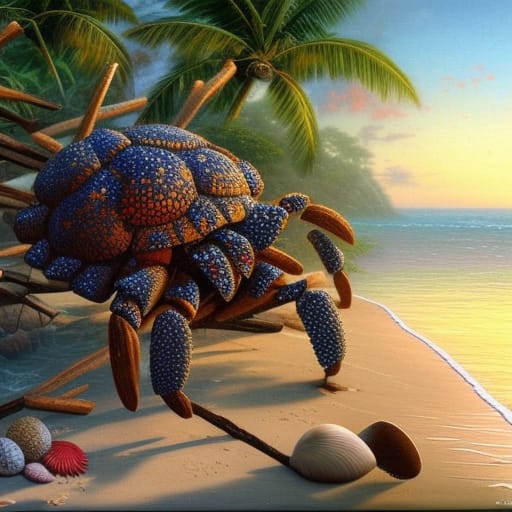Giant Coconut Crab
Primarily on the Island of Mawiti Atol in Evermyst They are an unusual Crustacean coming from aquatic origins that grows to incredible size. The Giant Coconut Crab is Known for its Highly resilient shell these Crabs typically grow above and beyond the size of a medium-sized dog Most Typical Coconut Crabs Grow to. Mawiti island is teaming with coconut crabs of this size but there are Gigantic versions that sometimes are born from the depths and transform making their way ashore onto the island and coral atolls with Primary body shell surface up to 10-12 feet. It is said that the Ilongo Shamen and Druids believe that these are reincarnations of ancient ancestors returning to the land. Druids have been known to charm such beasts and make use of them as beasts of burden or ride them into the waters and reef shoreline that dots many of these islands. The Giant Coconut crab feeds mainly on Coconuts and smaller crustation, rodents, birds, or fish. but the largest of these have been able to shear through plate armor or rip a person in two if provoked to attack. These Giant Coconut Crabs can live out of the water but can submerge and survive underwater for as much as 8 hours before needing to return to the land.
Basic Information
Anatomy
Giant Coconut Crabs have a Hard exoskeletal shell body with six legs and two very large claws. Their Eyes are at the the top of two short poles
Biological Traits
Giant Coconut Crab Males tend to get larger than females and can live well over 150 years
Genetics and Reproduction
These Gaint Coconut Crabs start as larvae in the sea at this time they can swim and only survive in the ocean. During mating season the males and females mate and the females lay eggs on the rocky shores that wash out to sea and hatch as larvae. mating season is typically 2 months long during the coolest months with eggs gestational period being approximately 1 Month before they hatch.
Growth Rate & Stages
Larvae (0-11 Months), Hermit Crab (1-4 years), Adult Coconut Crab (5-100 years), Huge Coconut Crab (100-150 years), Giant Coconut Crab (150+ Years)
Ecology and Habitats
Warm Tropical coastal regions such as islands and Atolls with an abundance of coconuts and shellfish, fish, or meat.
Dietary Needs and Habits
in the larvae stage they feed on plankton, at the hermit crab stage it is small insects, rotting flesh or small organisms. Upon Adulthood they move inland and feed on Coconuts, Rotting fruit, small rodents, or birds. When They Reach the Huge stage they feed on Many Coconuts, Medium sized animals but only need to feed about once a week. When they reach Giant sized, Then have been known to eat many a tree's Entire crops of Coconuts, or large animals such as Cattle, Carbao, huge Tuna, Reef Sharks just to name a few but only feed every 3-4 weeks.
Biological Cycle
Before becoming Giant Coconut Crabs in Their earlier stages these creatures molt and must seek new shells in stages before Adulthood often every 5-6 months. When they reach The Adult Coconut Crab stage they discard their harder outer carapace through molting and hide in caves or burrow underground until their new outer carapace hardens to resiliency. Much is unknown about the Transformation From Adulthood to Huge and Giant Coconut Stages of Life all that is known is that some of these creatures return to the Sea and undergo some sort of Transformation. Not All Adult Coconut Crabs Transform into Huge or Giant Coconut Crabs.
Behaviour
The Giant Coconut Crab is Nocturnal, for the most part, they avoid the daylight's heat to avoid Dehydration. They Are omnivorous and scavenger-like if food is scarce. They Typically Only attack Living creatures or animals if they feel threatened or are hungry. They are typically solitary but will fight one another over food or mates they are also cannibalistic.
Additional Information
Geographic Origin and Distribution
Giant Coconut Crabs are only found on Tropical Atolls or Islands.
Perception and Sensory Capabilities
Giant Coconut Crabs have a strong and highly efficient sense of smell to help them find their prey.
Their chemoreceptors are efficient enough to smell blood. In fact, their brain has devoted a large portion of it to detecting odors.
Its vision is nearly not quite 360 degrees with the eyes atop two independent poles.
Challenge Level (1-20)
10 (Huge) 12-14 (Giant)
Frequency
Rare
Number Encountered
1-4
Movement Types
Walk
10 (Huge) 12-14 (Giant)
Frequency
Rare
Number Encountered
1-4
Movement Types
Walk
Lifespan
150-300 years
Average Height
6-12' at the back feet standing on all legs.
Average Weight
300-2000 pounds.
Average Length
6 to as much as 20 feet across
Geographic Distribution






Comments